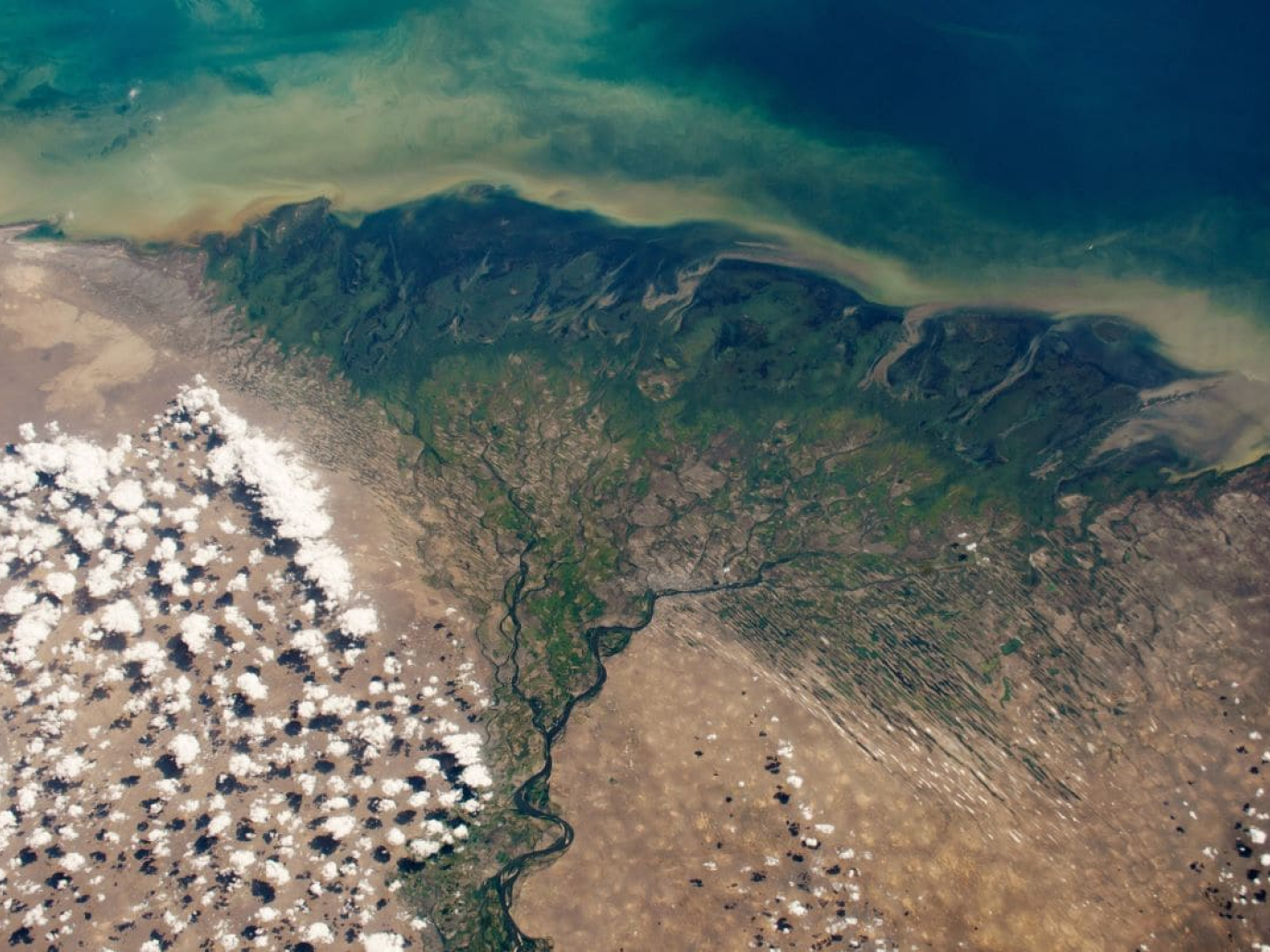This article is also available in Italian / Questo articolo è disponibile anche in italiano
from Moscow - Kazakhstan is concerned about the rapid decline in the level of the Caspian Sea, which has now reached its lowest point in a century for the second time. The phenomenon is having immediate repercussions on both natural ecosystems and economic activities, from the fishing industry to international logistics networks. There are growing fears that, in the long run, the largest inland body of water on the Eurasian continent could follow the fate of the Aral Sea.
The dredging operations undertaken to keep waterways open appear insufficient, and Kazakhstan sees cooperation with other littoral states as the only way to prevent its ports, Aktau and Kuryk, from drying up. In particular, it is looking to Moscow, requesting a greater release of water from the Volga, which contributes over 80% to replenishing the Caspian Sea's water reserves.
Experts we consulted, however, suggest that the Caspian’s falling water level is driven more by the evaporation process than by a reduced flow from rivers, a trend linked more to global warming than to human intervention.
Lastly, a study of statistical yearbooks reveals a cyclical pattern of rising and falling water levels. This may downplay the impact of human activity along the inflowing rivers, while leaving all theories on climate change valid.
The Caspian Sea is drying up rapidly
Neither sea nor lake, the management of the Caspian's waters is governed by the 2018 Convention signed by the littoral states. Its level is measured using the Baltic Height System, which takes the Kronstadt tide gauge as its reference point. It is a benchmark above the Caspian, meaning it is expressed in negative values.
At present, the surface of the Caspian stands at –29.21 metres relative to level 0, a figure alarmingly close to the historical low recorded in 1977. Between 1900 and 2023, the Caspian’s level has fluctuated between roughly 25 and 29 metres below sea level. A range exceeding three metres in total.
However, Kazakhstan's Ministry of Water Resources believes that by 2030, measurements could fall below the lower limit of the range and drop to -29.5/30.2 meters below Baltic Sea level if the littoral states do not take joint measures to curb the drying up.
Because of its shallow seabed, the north-eastern section of the basin is where the effects of the receding water are most visible. The shoreline has retreated by several kilometres in just a few years, and geographers from the Russian Academy of Sciences are even carrying out expeditions to document the formation of new islands south of the Volga delta.
The Caspian crisis hits Kazakhstan the hardest
The most serious consequences are being felt along the coast of Kazakhstan, the longest in the basin. “We are well aware that within 75 years we could lose this body of water,” said Kazakh MP Sergei Ponomaryov. “The sea is retreating at an average rate of 7 centimetres per year, and this trend has been ongoing for about 20 years. In 15 years, we will quite literally discover what environmental migrants are.”
According to Kazakhstan’s Ministry of Ecology and Natural Resources, since 2006 the surface area of the sea has shrunk by more than 31,000 square kilometres. If, hypothetically, the water level were to fall by another ten metres, up to 45% of the sturgeon spawning grounds, which are historically crucial to the local fishing industry, would be lost. The port of Aktau would end up 89 kilometres from the sea. In the event of a critical drop in water levels, 37% of the Caspian Sea’s surface, as much as 143,000 square kilometres, could disappear entirely, with economic losses in the region potentially exceeding 10 billion dollars annually.
The lowering of the seabed risks cutting Kazakhstan off from major infrastructure projects in Central Asia. To avoid running aground, ships can no longer travel at full cargo capacity. Where possible, shipping companies are turning to smaller vessels, leading to higher costs and falling profits. As a result, both Russia’s North–South corridor and the Caspian’s integration into China’s One Belt, One Road Initiative are at risk.
The role of the Volga River
Kazakh authorities believe that stabilising the Caspian Sea level would require an annual inflow of 279 cubic kilometres of water from the roughly 130 rivers that empty into the basin. Of this, at least 275 cubic kilometres should come from the great Russian river, the Volga. That amount would be sufficient to offset the current evaporation levels of 334 cubic kilometres per year, which are not compensated by the only 55 cubic kilometres of annual precipitation. In 2023, according to estimates from Kazakhstan’s Ministry of Water Resources, it was 60 to 65 less than what was needed.
From a legal standpoint, the Volga is an entirely Russian river, unlike the Ural, whose management is the object of an intergovernmental agreement between Russia and Kazakhstan. For this reason, Astana cannot submit direct demands to Moscow unless Russia agrees to establish a joint working group with the other littoral states.
In a recent parliamentary hearing, the deputy minister of water resources, Bolat Bekniyaz (now resigned) stated that the Kazakh government hopes to “cooperate on a legal basis” to manage the Volga’s flow, along which there are artificial reservoirs of several hydroelectric power plants.
Kazakhstan's demands to Russia
According to Stanislav Pritchin, head of the Central Asia section at the Institute of World Economy of the Russian Academy of Sciences, Kazakhstan’s demands are “excessive”. From both a legal and material point of view, it is unlikely that Moscow will be willing to take on further obligations beyond those already unilaterally agreed upon in the newly launched federal project for the restoration of the Volga.
Responding to our requests for comments on the Kazakh proposals, Pritchin stressed that across the entire Volga basin, including the main river and its tributaries, currently “no new reservoirs are being built or filled, nor are there any active water withdrawal projects.” The only exception, perhaps, is the supply of water to a Kazakh region with a severe water shortage: “To be clear, the Atyrau Oblast relies heavily on canals fed by the Volga.” The flow through the Volga’s plants, operational for decades, is now stable: “The water flowing upstream matches the one discharged downstream.”
It was during the construction of these large hydroelectric reservoirs, beginning in the 1930s, that the Caspian Sea first experienced a marked drop in level. Nevertheless, Mikhail Bolgov, a senior researcher at the Hydrology Institute of the Russian Academy of Sciences, does not believe it is possible to draw a direct correlation between changes in the Volga’s flow and fluctuations in the Caspian’s level.
“Because of its immense size, the sea accumulates the imbalance between inflow and evaporation over decades,” he explains. “Its level is determined by the combined effect of numerous factors over many years.”
Even evaporation itself cannot be seen as a linear process, as it tends to slow as the surface area of the water shrinks. It is also influenced not just by temperature, but by wind speed. “This is why we say the Caspian has a ‘memory’ of around 50 years or more,” the academic summarised. Trying to manage sea levels by acting on a single variable is therefore an unrealistic approach.
Cover: the delta of the Volga River where it flows into the Caspian Sea © NASA



